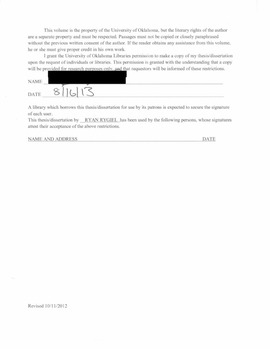| dc.contributor.advisor | Shehab, Randa | |
| dc.contributor.author | Rygiel, Ryan Charles Stanley | |
| dc.date.accessioned | 2017-08-28T16:20:54Z | |
| dc.date.available | 2017-08-28T16:20:54Z | |
| dc.date.issued | 2013 | |
| dc.identifier.uri | https://hdl.handle.net/11244/51930 | |
| dc.description.abstract | Approximately 4% of all fatal crashes in the United States (1,092) occurred in cross path collisions at signalized intersections (NHTSA, 2011). This type of crash is especially dangerous as the victim driver is often oblivious to the impending collision. With the invention of a new traffic monitoring system WICAS (King et al., 2007), a proposed system to warn victim drivers of these crashes was studied. Novel out-of-car signals were designed using best practices in traffic signal design for reaction time and using some form of a familiar traffic sign/signal currently in use. A survey was conducted to determine the signals' validity of use in a simulation study. The survey found that drivers were inclined to stop at the signals even when their implied meaning was not conveyed. Once the signals were approved, a simulation was performed using the STISIM driving simulator to test driver reaction time based on signal type and light onset distance. Three signal types were used in the study: a regular progression signal, a novel "Do Not Enter" traffic signal, and a novel Growing traffic signal at onset distances of 250 and 300 feet. A repeated-measures two-way ANOVA found a significant difference in reaction times based on the interaction between signal and light onset distance. Both novel signals provided faster reaction times to the warning regardless of the onset distance. Thus, the use of either of the proposed novel signals would give the victim driver additional time to stop and assess the situation. | |
| dc.format | x, 44 leaves : illustrations (chiefly color) ; 28 cm. | |
| dc.language | en_US | |
| dc.subject | Traffic signs and signals | |
| dc.subject | Traffic accidents -- Research | |
| dc.subject | Roads -- Interchanges and intersections | |
| dc.title | A validation of visual impending collision warnings for drivers heading straight through a signalized intersection | |
| dc.type | Thesis | |
| dc.type | text | |
| dc.contributor.committeeMember | Ling, Chen | |
| dc.contributor.committeeMember | Refai, Hazem | |
| dc.date.manuscript | 2013 | |
| dc.thesis.degree | Master of Science | |
| dc.note | Includes bibliographical references (leaves 35-36). | |
| ou.group | College of Engineering::School of Industrial and Systems Engineering | |
